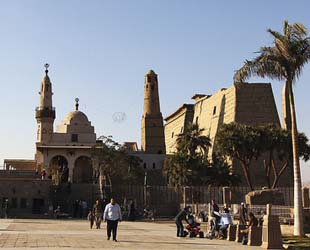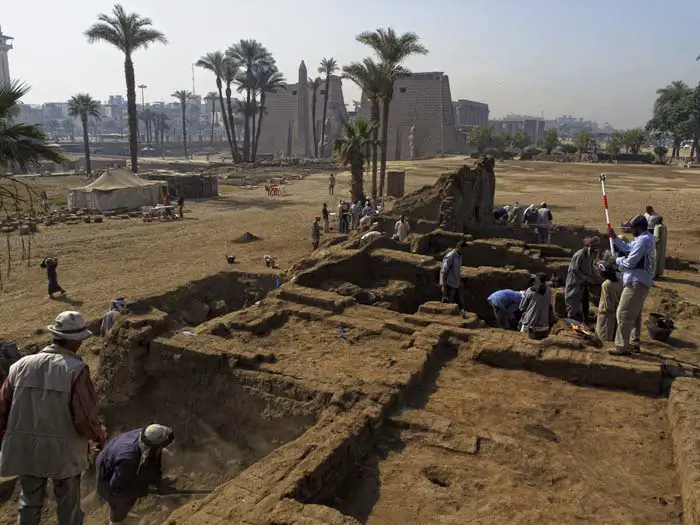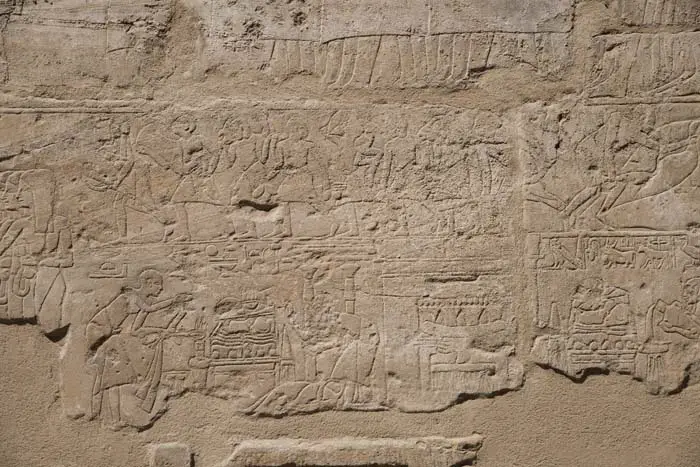The Luxor Temple
The Luxor Temple was one of the most powerful temples in Ancient Egypt, the temple deity being Amun or Amun-Ra. Beginning in the New Kingdom period, the power of Amun’s priesthood rivaled that of the Pharaoh. Luxor was also an important temple because of its location.
Location
The Luxor temple is in the middle of the ancient city of Thebes, on the east bank of the Nile. It is near the river bank. Luxor is a little over a mile from the temple complex of Karnak. Unlike most other Egyptian temples, Luxor has a north-south orientation. This is because the temple faced Karnak.
History and Construction
Scholars believe that pharaohs began building at Luxor before the New Kingdom Period. But the earliest extant features date to the reign of Amenhotep III. He was a New Kingdom pharaoh and he rebuilt the temple’s core, which included the Inner Sanctuary. Amenhotep III also added a sun court to the front of the temple and a colonnade to the front of the sun court.
The next major extant building phase dates to the reign of the New Kingdom pharaoh Ramesses II. He built the Great Court at the front of the colonnade. It was orientated to face Karnak and the processional way to Karnak ended there. He also built a triple barque shrine in the Great Court. This held the miniature boats that carried the statues of Amun, Mut, and Khonsu to Luxor during the Opet festival.

© kairoinfo4u - Entrance Pylon at Luxor
Ramesses II also built Luxor’s entrance pylon. The two obelisks and the colossal statues in front of the pylon also date to his reign. One of the obelisks and several statues are now in Paris. Ramesses II added his name to several older statues and rebuilt portions of the temple.
Several Late Period pharaohs also built at Luxor. Nectanebo II built a forecourt in front of the Great Court. He also rebuilt the sphinx statues lining the 1.2 mile processional way to Karnak. Serapis built a chapel that is in the forecourt and Shabaka built a kiosk there. Later rulers also restored parts of the temple.
Luxor was an important site to the ancient Egyptians. This is shown by the fact that Alexander the Great rebuilt part of the temple and added his own propaganda. He rebuilt the barque shrine inside the original core of the temple. Alexander had images carved on the shrine showing him as a pharaoh, sacrificing to Amun.
The Romans also used Luxor. They incorporated it into a fortress and rededicated Luxor to the cult of the Emperor. After Christianity became the religion of the Empire, the Romans built several churches in or near Luxor. They built one of these churches inside the Great Court.
In the 13th Century, Muslims built a mosque over the church in the Great Court. This mosque is still in use today. Scholars have determined that Luxor has been an active religious center for at least 3,000 years.

© Ahmad Rafiuddin - Mosque at Luxor
Excavation
The first modern European to identify Thebes and document his exploration of Luxor was Claude Sicard. He was a Jesuit and he visited Thebes in 1715. His work helped excite Europe’s interest in Egypt. This lead to the scientific expedition attached to Napoleon’s army.
This expedition measured and recorded the temple of Luxor in the early 1800s. They also found the Rosetta stone, which led to the decipherment of hieroglyphics. Scholars were then able to read the inscriptions at Luxor.
Egyptologists have continued to restore and maintain the Luxor temple. They have also conducted excavations and one of these found a cache of artifacts. When the Romans rededicated Luxor, they buried older statues of deities and pharaohs in a cache. In 1989, Egyptologists found this cache and some of the statues they found are in the Luxor Museum.

© Scott D. Haddow - Excavations performed at Luxor
Festivals
The most important Festival at Luxor was the Beautiful Feast of Opet. It was from this festival that the version of Amun worshiped at Luxor got his name, Amenemope. This name meant “Amun of the Opet” and the Egyptians called the temple the Southern Opet. The festival took place yearly during Akhet.
Akhet was the season when the Nile flooded. The Egyptians associated the Opet Festival with fertility. It lasted for anywhere from eleven days to one month, depending on the period of Egypt’s history. During the festival, the statues of Amun, Mut and Khonsu at Karnak traveled to Luxor in small boats.

© kairoinfo4u - Relief at Luxor, depicting the Beautiful Feast of Opet
The exact meaning of some of the festival’s parts which are depicted at Luxor are difficult to determine. Scholars believe there was a sacred marriage ceremony involving the king and queen that was a part of the festival. They also think the Egyptians believed the festival restored the Pharaoh’s power. There was a ritual coronation ceremony where the king received crowns from different deities.
Luxor Temple Facts
- Luxor has been an active religious site for at least 3,000 years.
- Scholars believe the Egyptians thought the Opet Festival at Luxor restored the Pharaoh’s power.
- Many pharaohs added to or restored Luxor.
- A cache of statues found at Luxor contained some of the most beautiful examples of Egyptian statuary found to date.
- The Egyptians dedicated Luxor to Amun and the cult practices were connected to his temple at Karnak.
- The Egyptians oriented Luxor north to south to face Karnak; instead of orienting it east to west like most Egyptian temples.
- Luxor was located in the center of Thebes.
